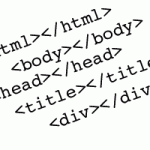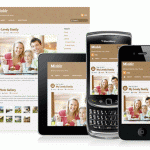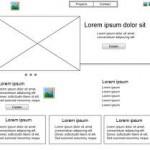Are You Doing it Wrong?: Common HTML Tag Misuses

“View the source code of a hand full of websites featured in CSS galleries today and you’ll often see the same errors appear time and time again. These mistakes are usually habits we picked up during our early days of coding that have stuck around due to lack of clarification. This post rounds up a collection of common HTML tag and element misuses and describes the best practice to correctly and semantically use them in your markup…”
Get defensive: Defensive web design and how will it help your website

“There are several types of design and every web designer decides for himself which approach he takes, but today we take a look at a particular one of them, called Defensive web design. What does it mean? The defensive design is also called contingency design and refers to the idea that the interface has to be designed in such a way that potential failures will not force the user away from your webpage, but will keep him there.
The contingency design can contribute a lot to your success, because all designers know there is not a product without flaws, therefore getting the best out of these flaws will help you keep your visitors close. Contingency design is familiar to a context that happens a lot in the stores. When the client goes and asks for something that is not in stock, he will not get rejected. The shop assistant will most of the time recommend another product. The defensive design does the same thing: takes the client’s mind away from the problem and helps him with information or makes him try again.”
Top 10 Places to Put an Opt-In Form

“An email list is the lifeblood of any internet based business. If you are running a blog or website for the sake of making money, an opt-in list is an absolute necessity. After all, the money is in the list. But after you design an opt-in form, one of your main decisions becomes where to actually place the form. Here is a list of 10 places that are great for an opt-in form (and remember, you can choose more than one).
1. Above the Header
If one of your top priorities is to build your opt-in email list, wouldn’t it make sense for the form to be the first thing that people see? Since the header is the first thing that most visitors look at when visiting a site, placing an opt-in form right above the header puts in a position of gaining maximum exposure.
There are a few ways to put an opt-in form above your header, but using a simple WordPress plugin is the easiest way to go. The Hello Bar and ViperBar are two of the more popular tools for this purpose.
On my website I prefer to use ViperBar because it has split testing capability. Some visitors will see a message that says ‘Free updates and access to all my ebooks’ is like a dream come true! And some will see ‘Get free updates from Reality Burst. No-spam Ever! EVER!’”
Educational Resources for Studying Graphic Design

“One of the greatest things about having access to the Internet, is the educational opportunities that it affords the public. People in all professions have the ability to expand their knowledge base through the wealth of information being shared via the Internet, and the same holds true for those who are studying graphic design.
The Internet is positively bursting with tutorials and resources that can help one advance through the various stages of becoming a successful graphic designer. All the way, from a newbie to an experienced pro. Today, that is our purpose here. Gaining knowledge about graphic design so that we can advance our skills and blossom in our chosen fields.
Here is a collection of invaluable educational resources on graphic design that have been broken down into different categories depending on your preferred methods of consumption. Each one of us has their own approach of learning, either learning visually, auditory or through repetitious means. It was in that vein in which the resources were collected.
We have tutorials for your hands-on approach, podcasts for a more auditory take and an assortment of PDFs and articles to read through.”
21 top tools for responsive web design

“To get started with building a responsive site, having a strong toolkit can make a world of difference. Here Denise Jacobs rounds up 21 great tools to aid the process of making your sites responsive
As introduced/coined by Ethan Marcotte in both his article Responsive Web Design as well as his recently released book, one needs three elements to make a site responsive:
- A flexible/fluid grid
- Responsive images
- Media queries
There are plenty of othergreat articles that cover motives, concepts, and techniquesregarding responsive web design, so we’ll keep the focus of this article on some top tools that will help you become responsibly responsive.”
5 Reasons to Optimize Your Site for Mobile

“It seems like the whole world has a smartphone these days. As of December 2010, a reported 31% of all US mobile phones were smartphones.
That means there’s likely to be a LOT of people viewing your website on a mobile device. Do you know what kind of experience those people have on your site? Does your site have a dedicated mobile version?
Here’s 5 reasons why we think it should.”
What is Responsive Web Design And How Can I Use It?

“Almost every new client these days wants a mobile version of their website. It’s practically essential after all: one design for the BlackBerry, another for the iPhone, the iPad, netbook, Kindle and all screen resolutions must be compatible, too. In the next five years, we’ll likely need to design for a number of additional inventions. When will the madness stop? It won’t, of course.
In the field of Web design and development, we’re quickly getting to the point of being unable to keep up with the endless new resolutions and devices. For many websites, creating a website version for each resolution and new device would be impossible, or at least impractical. Should we just suffer the consequences of losing visitors from one device, for the benefit of gaining visitors from another? Or is there another option?
Responsive Web design is the approach that suggests that design and development should respond to the user’s behavior and environment based on screen size, platform and orientation. The practice consists of a mix of flexible grids and layouts, images and an intelligent use of CSS media queries. As the user switches from their laptop to iPad, the website should automatically switch to accommodate for resolution, image size and scripting abilities. In other words, the website should have the technology to automatically respond to the user’s preferences. This would eliminate the need for a different design and development phase for each new gadget on the market.”
Real World CSS Practices

“By now, I think it’s safe to say that most designers on the web are using CSS in some capacity. Even those (misguided) individuals who are still using table-based layouts have a tendency to use CSS for some basic styling, such as establishing fonts and link colours. With that in mind, I thought it might be worthwhile cover some of what I have found to be best practices.
Before getting started, it’s important to note that these are practices and habits that I have developed based on my own experience, which includes developing different sites, my own experiments and reading from a variety of sources. While I have my own reasons for the way I do things, I am in no way presenting the following as CSS gospel that absolutely needs to be followed.
As with anything, take what you read, weigh it against your own knowledge, values and experience in order to formulate your own methodology.”
Wireframing is About More than Just Visual Layout

“Over the past couple of days, I have been working on an initial concept/prototype for a new, interesting website. As I normally like to do whenever I am tackling a new project, I started by opening up a notebook and making a few really simple layout sketches for how I initially thought the page should be laid out (at this stage, I am just working the layout for a single type of page, with others following later). After discussing these initial concepts with members of the team I am working with, I very logically moved on to the creating more fully realized wireframes. For me, this meant printing of some grids and using a pen to draw and label content boxes.
The process, however, started me thinking about wireframes, their importance and the role(s) that they play in the design and development process. More specifically, it got me thinking about how wireframing even in the rudimentary pencil on a paper grid method that I use may be even more important and useful than it may initially appear, or than we like to give it credit for.”



